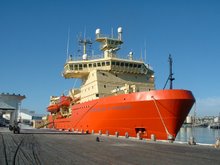stronger winds than we've seen in a few days. Of course what happens
in march probably means something different in the southern hemisphere.
Since I promised to finish the collection techniques review today
(and I know you're waiting anxiously) I'll do that. But going back
to a post from a few days ago, I mentioned I was feeling like I
haven't had enough time to talk about the data and digest it. I had
a talk with at least 5 or 6 other people today because we had some
time to catch our breath -- and it turns out everyone was having the
same problem I am. So no need to worry, I guess this is something
normal on a cruise. Still, having a captive audience of people who
are willing to, and can help, your research, is something we all want
to take advantage of. The "science" talks are ok for this, but we're
hoping to maintain an informal, but scheduled discussion to mix up
ideas...we'll see if it happens.
Anyway, the second collection technique I'm responsible for on my
round around the rosette is not as fun, as it involves fewer power
tools, less hammering, and more immersion in water. We're looking to
capture CFC's and SF6 concentrations in water. The alert among you
will recognize CFC's as ozone-destroying molecules. Well they are
also great for determining how long it's been since water has been
"ventilated", i.e. at the surface of the ocean long enough to
exchange gas with the atmosphere. SF6, likewise, is an "age"
tracer. It's used, I think, in transformers as an insulator --
these compounds were developed for their stability, which is a good
thing as long as they don't do any harm while their floating around
the atmosphere or ocean.
Unfortunately for me, these gases are not very soluble in water,
meaning they're very hard to keep the gas in, and very susceptible to
contamination by ambient air. So here's the technique, which we are
praying is enough to keep the gas in place on its long journey from
the rosette to the refrigerator to Punta Arenas to New York. First,
I attach a plastic tube to the rosette and fill up a flask with
water. The flask is inside a plastic mayo-sized jar, which is inside
a milk-jug sized plastic cylinder. When the flask is full and
overflowing, I cap the flask (with no air inside), remove the flask,
turn in over, and place it upside down inside the mayo jar. Then
holding the flask upside down, I get the mayo cap, hold that
underwater (making sure the tube is still flowing and in the milk
jug) until the mayo jar is full and overflowing into the milk jug. I
turn the cap around until the air leaves the cap, then place the cap
on the mayo jar, and (this is the hardest part), screw it on, making
sure it's aligned and airtight in the tight confines of the plastic
cylinder. Did I mention the water here is in a tight range between
-2 and 1 degrees? Then I remove the mayo jar, with flask inside,
turn it over, and see if there are any air bubbles. If there are, I
dump it and do it again. If not, I move on the next bottle.
Like I said, I hope this works.


1 comment:
Hey Christopher-
I just wanted to say hi! I am a little slow w/ the technology and all, so I am just figuring out how to write. Everything sounds excellent there- so cool to think of you doing all this stuff. Stay warm out there and if you see any penguins as cute as ketzie say hi to them for me!
C
Post a Comment